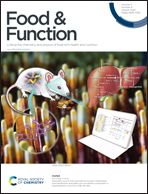Milk whey from different animal species stimulates the in vitro release of CCK and GLP-1 through a whole simulated intestinal digestion
Abstract
Milk whey is effective in enhancing satiety mainly due to its protein composition. Peptides and amino acids derived from digestion of whey protein can act as suppressants of appetite by stimulation of receptors of satiety gut hormones. But, the protein fraction of whey can vary depending on species of animal, season, lactation period, etc. The aim of this study is to evaluate the satiety effect of milk whey from different species of ruminants (cow, sheep, goat and a mixture of them) through a simulated in vitro digestion, which performed the whole gastrointestinal process, from oral digestion to colonic fermentation. The satiety effect of each sample was measured by the production of satiating hormones (CCK and GLP-1) secreted by enteroendocrine cell line (STC-1) after 2 hours of incubation with non-digested, digested and fermented whey. Digested samples have shown to be potent CCK and GLP-1 secretagogues followed by fermented and non-digested samples, showing that the last one showed a weak hormone stimulation. Digested goat whey was the most efficient stimulator of GLP-1 (86.33 ± 4.55 pg mL−1) and fermented mixture whey produced the major release of CCK (80.78±1.81 pg mL−1). This study demonstrates that milk whey is a suitable ingredient to stimulate satiety through the effect of peptides, amino acids produced from digestion, and metabolites released by fermentation.



 Please wait while we load your content...
Please wait while we load your content...